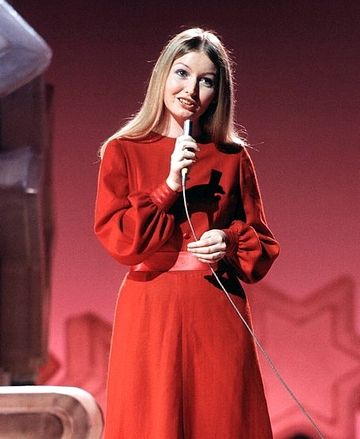In the turbulent year of 1968, when the world was rocked by social upheaval and cultural revolutions, a haunting melody pierced through the noise and left an indelible mark on history. Mary Hopkin’s iconic hit, “Those Were the Days,” is far more than just a song—it’s a nostalgic journey to a simpler, more innocent time that continues to resonate deeply across generations today.
The origins of this unforgettable tune stretch back decades and oceans away. Originally, it was a Russian romance ballad called “Dorogoi dlinnoyu” (“By the Long Road”), composed in the 1920s by Boris Fomin with lyrics by Konstantin Podrevsky. This somber folk melody mourned lost youth and faded love, themes universally understood and profoundly felt globally. In the 1960s, amid a folk music revival led by giants like Bob Dylan and Joan Baez, American producer Gene Raskin breathed new life into the song by adapting the poignant lyrics into English—capturing the aching essence of longing and remembrance.
The story took a dramatic turn when Paul McCartney, steering the helm of Apple Records, discovered the tender and ethereal voice of young Welsh singer Mary Hopkin. Her breathtaking rendition of “Those Were the Days” skyrocketed to the top of the UK Singles Chart and soared to number two on the US Billboard Hot 100—a staggering feat given the rock and psychedelic dominance of the era. McCartney’s bold choice to champion a song steeped in folk tradition contrasted sharply with the electric sounds of the ’60s, but it was exactly this simplicity amidst the psychedelic chaos that captured the hearts of millions.
The musical arrangement is mesmerizing in its blend of cultures. The use of the balalaika, a Russian folk instrument, infuses the track with a rich Eastern European flavor, grounding it in timeless tradition. The melody’s repetitive, circular nature mimics the cyclical passage of memories—a hypnotic dance on the strings that lulls listeners into reflective reverie. Paired with Hopkin’s wistful vocals, the song becomes a vessel transporting one to laughter-filled evenings and friendships that once felt eternal.
Lyrically, “Those Were the Days” is both a balm and a sting—a yearning cry for youth’s fleeting glow. The opening lines, “Those were the days, my friend / We thought they’d never end,” encapsulate a universal truth: the bittersweet realization that no matter how cherished, such moments slip irretrievably through time’s grasp. As friends scatter and time marches on, the song mourns the passage brilliantly while celebrating the vibrancy of the memories left behind.
Its cultural impact is nothing short of phenomenal. Diverging from the era’s rebellious rock and psychedelic experiments, the song offered a sentimental refuge—a reminder of simpler joys and deeper connections. Its global success saw it conquering charts across Europe, the US, and the UK. Covered by numerous artists and translated into multiple languages, “Those Were the Days” has become a perennial anthem, threaded through films, commercials, and television, echoing themes that resonate deeply with the human experience.
But what fuels the timeless endurance of “Those Were the Days”? It’s the powerful simplicity of nostalgia, a universal ache for cherished times lost and friendships that time cannot fully erase. Hopkin’s tender voice combined with the haunting folk melody create an emotional sanctuary—a shared lullaby weaving personal memories into a collective emotional tapestry.
One can almost hear Mary Hopkin herself reflect, “It’s not just a song—it’s a memory brought to life every time someone listens.” Indeed, in an age hurtling forward into the dizzying speed of modern change, this song remains a sacred refuge, a reminder of our shared humanity and the simple joys that unite us.
As decades pass, “Those Were the Days” by Mary Hopkin refuses to fade into obscurity. Instead, it stands defiant, a poignant beacon shining a light on the beauty and sadness of reminiscence—forever etched into the hearts and souls of all who yearn for a glimpse of their own unforgotten yesterdays.
Video
Lyrics: Those Were the Days
Once upon a time there was a tavern
Where we used to raise a glass or two
Remember how we laughed away the hours
Think of all the great things we would doThose were the days, my friend
We thought they’d never end
We’d sing and dance forever and a day
We’d live the life we choose
We’d fight and never lose
For we were young and sure to have our wayThen the busy years went rushing by us
We lost our starry notions on the way
If by chance I’d see you in the tavern
We’d smile at one another and we’d sayThose were the days my friend
We thought they’d never end
We’d sing and dance forever and a day
We’d live the life we choose
We’d fight and never lose
Those were the days
Oh, yes, those were the daysJust tonight I stood before the tavern
Nothing seemed the way it used to be
In the glass I saw a strange reflection
Was that lonely woman really meThose were the days my friend
We thought they’d never end
We’d sing and dance forever and a day
We’d live the life we choose
We’d fight and never lose
Those were the days
Oh, yes, those were the daysThrough the door there came familiar laughter
I saw your face and heard you call my name
Oh my friend we’re older but no wiser
For in our hearts the dreams are still the sameThose were the days my friend
We thought they’d never end
We’d sing and dance forever and a day
We’d live the life we choose
We’d fight and never lose
Those were the days, oh yes, those were the days
